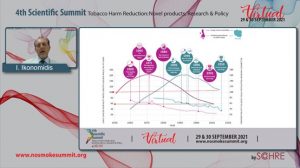The session discussed the Future of Smoking in Europe focusing on regulation, data generation and European Commission’s Beating Cancer Plan.
Professor Karl Fagerström in his presentation “Sweden: Harm Reduction and Endgame. Target Achieved” discussed the current smoking prevalence in Sweden as well as Swedish Snus, an alternative tobacco product that can assist in smoking cessation and reduce tobacco mortality.
As well as several other countries, Sweden has adopted an Endgame definition. It is a concept aiming to end the tobacco epidemic and is defined by a smoking prevalence rate below 5%. According to Eurobarometer (2021), the smoking prevalence for Sweden was 4%, making it the only country in the European Union (EU) below the 5% Endgame mark. Further, in a recent study compiled from the Global Burden of Disease (2019), the death rates attributable to tobacco in Sweden were the lowest compared to the EU.
According to the Tobacco Control Score (2019), Sweden ranked 15th amongst the other European countries. This meant that even though Sweden had the lowest smoking prevalence, it had not implemented strong tobacco control measures. The speaker suggests that Snus, an alternative tobacco product, had largely replaced smoking over the recent years. A similar trend was also observed in Norway.
Professor Fagerström concluded that combustible products like cigarettes can be replaced. The non-combustible products including Snus are significantly less harmful whilst nicotine pouches without tobacco are believed to be even less harmful.
SCOHRE Position on “Beat Cancer” Plan
Dr Ignatios Ikonomidis discussed the tobacco epidemic, Europe’s Beating Cancer Plan (BECA) and highlighted where SCOHRE stands―as president of the newly founded International Association on Smoking Control & Harm Reduction.
According to the American Cancer Society the cumulative tobacco related deaths were 175 million (2005-2030). The risk of getting lung cancer was 25 times higher for smokers than for non-smokers (both sexes 2000-2010). When implementing tobacco control measures (education, increasing taxation etc) in the United States, the number of cigarettes sold decreased, in turn decreasing lung cancer mortality. Similar trends were observed in Norway, a country with a significantly better health care system. However, this was not the same for Poland as lung cancer mortality rates were still high.
In 2020, there were 2.7 million cancer incidences and 1.3 million deaths in the EU. In February 2020, the European Beating Cancer Plan was introduced. It was a political commitment to reduce cancer in response to the growing challenges and an initiative for harm reduction policies to further reduce the smoking prevalence.
As we at SCOHRE Position point out, Dr Ikonomidis said, the plan did not discuss the evidence that e-cigarettes and novel tobacco products (NTPs) appear to have lower risk of exposure to toxicants compared to conventional cigarettes. The exact level of risk reduction is inevitably uncertain, but both are promising harm reduction agents for smokers that fail or are unwilling to quit smoking. The Plan aims to prioritize’ protecting young people from conventional and e-cigarette smoking. The Plan also proposes measures such as banning non-tobacco flavors for e-liquids and suggests regulatory protection for adolescent use making them strictly available for adults.
Dr Ikonomidis concluded that SCOHRE , based upon global experience, suggests harm reduction policies should be included to improve the rates of smoking cessation and contribute to the reduction of smoking consequences. Harm reduction should be considered as the third pillar for tobacco control together with smoking cessation and smoking prevention.
Panellists Discussion: Opinions and Proposals
The first speaker, Dr Fernando Fernandez Bueno highlighted that even though scientists believe Tobacco Harm Reduction (THR) products can assist in smoking cessation, there are many outside the scientific community such as politicians and the media that are against these products. The speaker highlighted the importance of educating the public around THR products.
The second speaker, Dr Ioannis Boukovinas, MD, PhD, Medical Oncologist, shared his ideas based on his cancer patients’ experiences. The speaker agreed that harm reduction is an alternative for smoking cessation however pointed out the need for more toxicology data and biological pathways of cancer. Focus should be given to epigenetic changes and how to achieve lower rates of nitrosamines in e-cigarettes. The speaker further pointed out that we do not know the exact vaporing impacts of e-cigarettes on stress hormones that create cancer. Therefore, more data on the product’s complete safety will help clinicians in counselling. The speaker also referred to the difference in smoking habits throughout Europe, emphasising the gap between the Northern and Southern parts of Europe. Dr Boukovinas concluded the importance of more data on the long-term implications of e-cigarettes and the significance of cessation and prevention approaches to target adolescents.
Mr. Bengt Wiberg, the third speaker, then pointed out that Sweden, Norway, and Iceland already have data and have reached the 5% Endgame target. The speaker said that the Swedish Experience data should be available to all Europeans instead of inventing the wheel. Lastly, the speaker highlighted that BECA does not acknowledge the great disparity in risk between combustible and non-combustible nicotine products.
Dr Ikonomidis underlined that nicotine itself is not the problem. In the long term, switching from a tobacco product to another non-combustible product can significantly improve health. The speaker highlighted that clinicians are afraid of Snus used for pleasure and not with the intention to quit smoking because the effects on health are still unknown.
Dr Boukovinas also highlighted that when tobacco constrain measures were implemented (including taxation, banning tobacco advertising etc) there was a decrease in cancer from 2005-2015, but then a plateau was reached. The speaker suggested open minded approaches using new technology that can make toxicology and biological analysis on new products. Improved, stricter regulations for adolescents were recommended and the need for an “observatory” for novel products has been stressed.
Here Mr. Wiberg added that Sweden has a registry, “big data” spanning back many years including extensive patient information and information on cancer and mortality. A new initiative, as announced, is that in 2022, Sweden will have a novel tobacco cohort, managed and registered by dentists, registering information on the use of conventional cigarettes, snus, or nothing, that will allow comparisons.
Dr Ikonomidis concluded the panel discussion emphasising the importance of observatory data and how this approach will support harm reduction policies. He also stressed that SCOHRE will present and discuss novel research and ideas in the upcoming forums as well as discuss future perspectives with the aim to reduce tobacco mortality.



